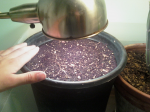Proper Title:
1. It is well known that various Ipomoea species, such as Ipomoea tricolor, I. violacea and others in addition to other Convolvulaceae plants such as Turbina corymbosa and Argeria Nervosa contain endophyte fungi that product lysergamides in the seeds, leaf, and stem. However, not all of each species of each genus listed contain this fungi, nor does every genus in the Convolvalacea family contain a fungi that produces lysergamides.
2. Cuscuta campstris and other dodders have been used and recorded to not only be in the Convolvalacea family, but also to infect other plants with organisms from other plants they are simultaneously parasitisizing.
3. It should be relatively easy to grow a non-infected Convolvalacea with an infected Convolvalacea plant, along side Cuscuta campstris to make the non-infected plant a newly infected plant that also produces lysergic acids in its seeds, leaf, and stem.
Since the world sucks, it isn't present in roots and so there goes the idea of a really revolutionary Sweet Potato Farm (Ipomoea batatas) (boo )
)
--> It might be able to infect plants in the same order, not just the same family -- this could possibly lead to psychoactive (LSA styled) Tomato, Tobacco ,EggPlant, and Datura plants, but I find this really pushing it.
It is reasonable to me, to assume that ALL genuses within the Convolvulaceae family can support this fungi, and allow it to produce lysergamides - They have have yet to be infected by it.
Here is an incomplete and perhaps false list of the genus's present in the Convolvulaceae family.
Articles:
1. http://www.thelaboratory.org/talk/proposed-experiments/transferring-a-lyseramide-producing-endophyte-to-different-convolvulaceae
2. http://www.springerlink.com/content/kby3dh4vedhcn14l/
3. http://www.plantphysiol.org/content/147/1/296.full
4. http://aem.asm.org/cgi/content/abstract/73/8/2571
5. http://www.ncbi.nlm.nih.gov/pubmed/17133714
6. http://en.wikipedia.org/wiki/Phytoplasma -- "Phytoplasmas can also be spread via dodders cascutaceae[13] or vegetative propagation such as the grafting of a piece of infected plant onto a healthy plant."
7. http://onlinelibrary.wiley.com/doi/10.1111/j.1439-0434.1991.tb00132.x/abstract
8. http://www.ars.usda.gov/research/publications/publications.htm?seq_no_115=74439
9. http://www.crcnetbase.com/doi/abs/10.1201/9781420069327.ch22
Transferring a Lysergamide Producing Endophyte To Different Convolvulaceae species from a psychoactive strain of Argeria Nervosa var Nervosa collected wild from Hawaii using the parasitic Convolvulaceae plant Cuscuta campstris as the endophyte transferring vector.
1. It is well known that various Ipomoea species, such as Ipomoea tricolor, I. violacea and others in addition to other Convolvulaceae plants such as Turbina corymbosa and Argeria Nervosa contain endophyte fungi that product lysergamides in the seeds, leaf, and stem. However, not all of each species of each genus listed contain this fungi, nor does every genus in the Convolvalacea family contain a fungi that produces lysergamides.
2. Cuscuta campstris and other dodders have been used and recorded to not only be in the Convolvalacea family, but also to infect other plants with organisms from other plants they are simultaneously parasitisizing.
3. It should be relatively easy to grow a non-infected Convolvalacea with an infected Convolvalacea plant, along side Cuscuta campstris to make the non-infected plant a newly infected plant that also produces lysergic acids in its seeds, leaf, and stem.
Since the world sucks, it isn't present in roots and so there goes the idea of a really revolutionary Sweet Potato Farm (Ipomoea batatas) (boo
 )
) --> It might be able to infect plants in the same order, not just the same family -- this could possibly lead to psychoactive (LSA styled) Tomato, Tobacco ,EggPlant, and Datura plants, but I find this really pushing it.
Quote
Order: Solanales
Family: Convolvulaceae (Morning Glory, etc)
VS
Order: Solanales
Family: Solanacea (Tomato, Potato, Tobacco, Pepper, Eggplant, Datura, etc)
It is reasonable to me, to assume that ALL genuses within the Convolvulaceae family can support this fungi, and allow it to produce lysergamides - They have have yet to be infected by it.
Here is an incomplete and perhaps false list of the genus's present in the Convolvulaceae family.
Quote
Tribe Aniseieae
* Aniseia Choisy
* Iseia O'Donell
* Odonellia K.R.Robertson
* Tetralocularia O'Donell[3]
Tribe Cardiochlamyeae
* Cardiochlamys Oliv.
* Cordisepalum Verdc.
* Dinetus Buch.-Ham. ex Sweet
* Poranopsis Roberty
* Tridynamia Gagnep.[4]
Tribe Convolvuleae
* Calystegia R.Br. - Bindweed, Morning glory
* Convolvulus L. - Bindweed, Morning glory
* Polymeria R.Br.[5]
Tribe Cresseae
* Bonamia Thouars
* Cladostigma Radlk.
* Cressa L.
* Evolvulus L.
* Hildebrandtia Vatke
* Itzaea Standl. & Steyerm.
* Neuropeltis Wall.
* Neuropeltopsis Ooststr.
* Sabaudiella Chiov.
* Seddera Hochst.
* Stylisma Raf.
* Wilsonia R.Br.[6]
Tribe Cuscuteae
* Cuscuta L. - Dodder[7]
Tribe Dichondreae
* Calycobolus Willd. ex Schult.
* Dichondra J.R.Forst. & G.Forst.
* Dipteropeltis Hallier f.
* Falkia Thunb.
* Metaporana N.E.Br.
* Nephrophyllum A.Rich.
* Porana Burm.f.
* Rapona Baill.[8]
Tribe Erycibeae
* Ericybe Roxb.[9]
Tribe Humbertieae
* Humbertia [10]
Tribe Ipomoeeae
* Argyreia Lour. - Hawaiian baby woodrose
* Astripomoea A.Meeuse
* Blinkworthia Choisy
* Ipomoea L. - Morning glory, Sweet potato
* Lepistemon Blume
* Lepistemonopsis Dammer
* Paralepistemon Lejoly & Lisowski
* Rivea Choisy - Coaxihuitl
* Stictocardia Hallier f.
* Turbina Raf.[11]
Tribe Jacquemontieae
* Jacquemontia Choisy[12]
Tribe Maripeae
* Dicranostyles Benth.
* Lysiostyles Benth.
* Maripa Aubl.[13]
Tribe Merremieae
* Decalobanthus Ooststr.
* Hewittia Wight & Arn.
* Hyalocystis Hallier f.
* Merremia Dennst. ex Endl. - Hawaiian woodrose
* Operculina Silva Manso
* Xenostegia D.F.Austin & Staples[14]
Not placed in tribe
* Pentacrostigma K.Afzel.
Articles:
1. http://www.thelaboratory.org/talk/proposed-experiments/transferring-a-lyseramide-producing-endophyte-to-different-convolvulaceae
2. http://www.springerlink.com/content/kby3dh4vedhcn14l/
3. http://www.plantphysiol.org/content/147/1/296.full
4. http://aem.asm.org/cgi/content/abstract/73/8/2571
5. http://www.ncbi.nlm.nih.gov/pubmed/17133714
6. http://en.wikipedia.org/wiki/Phytoplasma -- "Phytoplasmas can also be spread via dodders cascutaceae[13] or vegetative propagation such as the grafting of a piece of infected plant onto a healthy plant."
7. http://onlinelibrary.wiley.com/doi/10.1111/j.1439-0434.1991.tb00132.x/abstract
8. http://www.ars.usda.gov/research/publications/publications.htm?seq_no_115=74439
9. http://www.crcnetbase.com/doi/abs/10.1201/9781420069327.ch22






